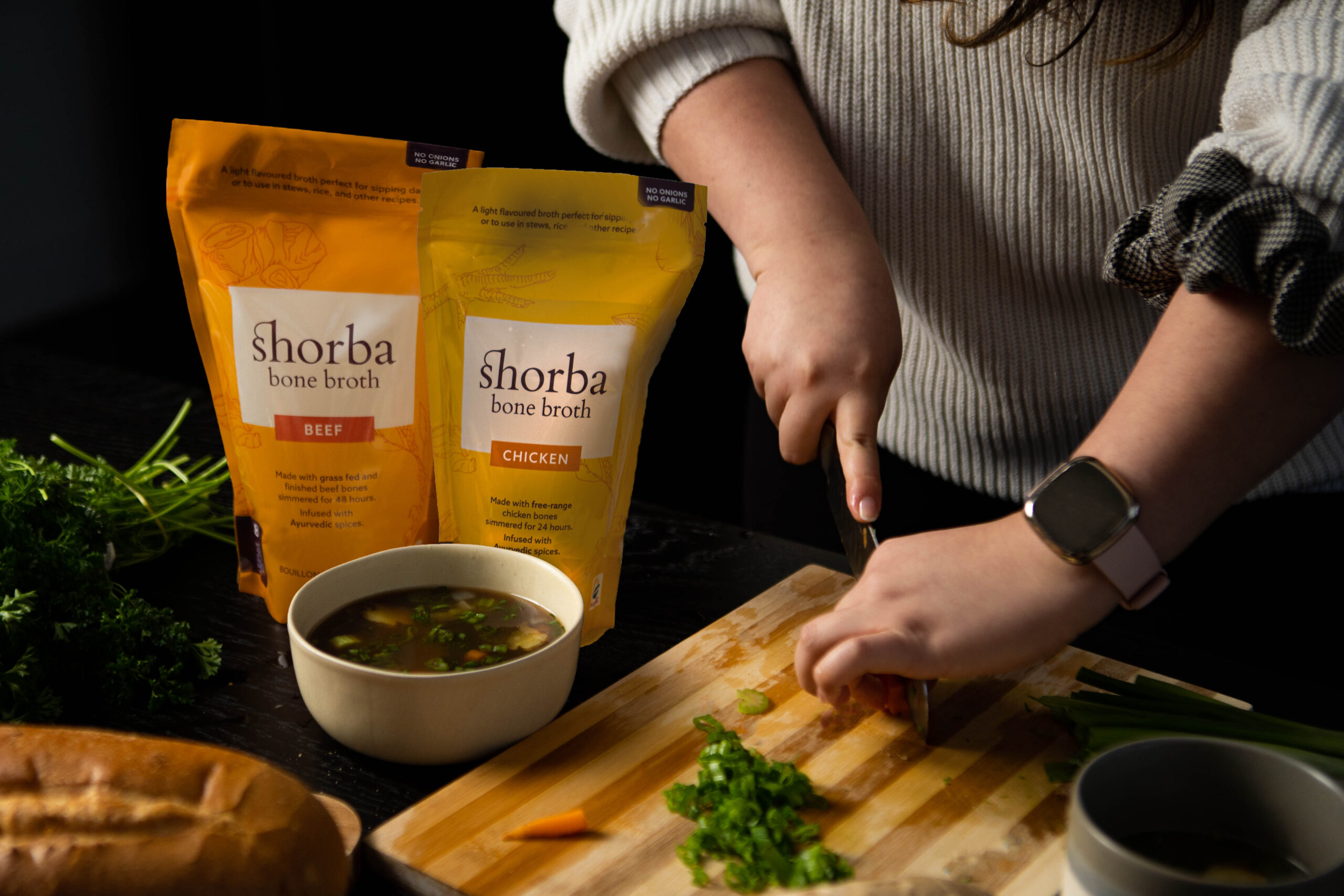How to Choose the Right Bone Broth Delivery Service for Your Diet
How to Choose the Right Bone Broth Delivery Service for Your Diet
Blog Article
The Ultimate Guide to Making and Taking Pleasure In Organic Bone Broths in the house
Bone broth has acquired attention for its countless health benefits and culinary versatility. Crafting natural bone broth in your home allows individuals to regulate the top quality of components, making certain a nutritious result. Understanding the option of bones, crucial flavor parts, and appropriate cooking techniques is essential. As the procedure unravels, one might ask yourself exactly how to elevate their broth past the essentials and include it into everyday dishes for boosted flavor and nourishment.
Recognizing the Health And Wellness Perks of Bone Brew
Although bone broth has been a staple in different cuisines for centuries, its wellness advantages have acquired considerable interest in current years. Rich in collagen, amino acids, and minerals, bone broth is often touted for its prospective to sustain joint wellness, enhance intestine function, and improve skin elasticity. The jelly stemmed from prepared bones might aid digestion and help seal the digestive tract cellular lining, possibly minimizing problems like leaky intestine syndrome.Furthermore, the existence of nutrients such as glucosamine and chondroitin may add to lowered swelling and pain alleviation in joints. In addition, bone broth is moistening and can function as a nutritious base for soups and stews. Many proponents additionally assert that it boosts the immune system, many thanks to its mineral account. In general, the revival of rate of interest in bone broth is linked to its viewed ability to promote overall well-being and support different physical features.
Picking the Right Bones for Optimum Taste and Nutrition
What aspects should one take into consideration when selecting bones for brew prep work? The type of bones utilized considerably affects both flavor and dietary value. First, it is important to select bones that consist of a mix of marrow bones, joint bones, and meaty bones. Marrow bones offer healthy fats and rich flavors, while joint bones contribute collagen, improving the brew's nutritional profile.Additionally, sourcing bones from grass-fed or pasture-raised animals warranties greater quality and more nutrients, as these animals are typically much healthier. The freshness of the bones is likewise crucial; picking bones from local butchers or farmers' markets can ensure ideal flavor. Bone size matters also; bigger bones launch even more jelly, resulting in a richer brew. Thinking about the kind of pet-- fish, poultry, or beef-- can affect the last taste, permitting for flexible brew alternatives tailored to private choices.
Important Components for a Flavorful Bone Broth

Quality Bone Option
The structure of a savory bone brew lies in the careful choice of high-quality bones. Sourcing natural, grass-fed or pasture-raised bones is crucial, as these options are most likely to be without unsafe additives and give exceptional nutrients. Selections such as poultry, beef, or lamb bones each impart distinct tastes and health benefits. Bone types, including marrow bones, knuckle bones, and oxtails, contribute jelly and collagen, enhancing the brew's structure. Choosing bones with a mix of meat and connective tissue can also add splendor and deepness. Additionally, choosing bones with visible marrow guarantees a nutrient-dense broth, boosting the total quality. Inevitably, spending time in top quality bone option prepares for a beneficial and tasty brew.
Aromatic Flavor Enhancers
Selecting top quality bones sets the phase for a rich and nutritious bone broth, yet it is the addition of aromatic taste enhancers that absolutely elevates the dish. Active ingredients such as onions, garlic, and carrots not just pass on sweetness but also contribute deepness to the brew. Fresh natural herbs like parsley, bay, and thyme leaves include a great smelling note, while flavors such as black peppercorns and cloves present warmth and complexity. Furthermore, including a sprinkle of apple cider vinegar can help essence minerals from the bones, improving the brew. These flavor boosters produce an unified mix, changing an easy broth into a tasty structure for soups, stews, or sauces, making it a functional element in any culinary arsenal.
Step-by-Step Guide to Making Bone Brew in the house
Producing bone broth in the house can be a satisfying cooking venture that improves both flavor and nutrition in numerous recipes. To begin, one have to select premium bones, preferably from organic or grass-fed sources. Roasting the bones at 400 ° F for about half an hour can increase the flavor. Next off, transfer the baked bones to a large pot or sluggish cooker and cover them with chilly water. Including a sprinkle of vinegar assists remove minerals from the bones.Include aromatic veggies like onions, carrots, and celery for added deepness, along with natural herbs and spices as wanted. Bring the mixture to a boil, after that decrease to a simmer. It is necessary to let the broth simmer for a minimum of 12 hours, however much longer is more effective for maximum richness. Ultimately, strain the broth through a fine-mesh sieve and shop it in closed containers, all set to raise dishes with its nourishing essence.

Tips for Refining Your Bone Broth Simmer
While simmering bone brew, maintaining the appropriate temperature level and timing is essential for achieving a abundant and delicious result. A gentle simmer, preferably in between 190 ° F and 210 ° F, helps extract maximum nutrients and flavors without boiling, which can make the broth cloudy. It is recommended to keep track of the pot very closely, adjusting the heat as required to maintain this simmer.Timing is also vital; a longer simmer, generally varying from 12 to 2 days, permits deeper taste removal and collagen launch. For chicken bones, a 12 to 24-hour simmer is adequate, while beef bones profit from longer food preparation times.Additionally, skimming off any foam or pollutants that increase to the surface during the first couple of hours can enhance the brew's quality and preference. Ultimately, making sure the pot is covered throughout simmering assists to preserve dampness and increase the flavors, making for an extra rewarding output.
Imaginative Ways to Make Use Of Bone Broth in Your Food preparation
Integrating bone broth into numerous dishes boosts both flavor and nutritional worth. Chefs and home chefs alike discover that utilizing bone brew as a base for soups and stews boosts depth and splendor, changing basic dishes right into hearty dishes. It can additionally be used in risottos, where the broth changes water, allowing the grains to absorb its full-flavored essence.Additionally, bone brew acts as an exceptional cooking fluid for grains like quinoa or rice, instilling them with nutrients and flavor. For an added spin, it can be utilized in braising meats, resulting in tender, savory results. Also sauces take advantage of a dash of bone broth, improving their preference profile.Moreover, bone brew can be incorporated into smoothies for an unanticipated wellness boost, supplying healthy protein and nutrients without compromising taste. These creative applications showcase the adaptability of bone brew in day-to-day food preparation, making it an invaluable kitchen staple.
Saving and Preserving Your Homemade Bone Broth
Appropriate storage and conservation of homemade bone broth is crucial for maintaining its flavor and dietary benefits. Freezing strategies and refrigeration ideal methods play a crucial role in prolonging the broth's rack life. Understanding these approaches can assist assure that the broth stays delicious and safe for future use.

Freezing Techniques Described
Cold methods are crucial for successfully keeping and protecting self-made bone brew, ensuring its rich tastes and nutrients remain intact for future usage. To ice up bone brew, it is a good idea to let it cool entirely before moving it to storage space containers. Glass jars, silicone mold and mildews, or durable freezer bags appropriate alternatives. When making use of containers, leave space at the top for expansion during cold. Portioning the brew right into smaller sized quantities enables simple thawing and decreases waste. Label containers with the day and contents for very easy identification. For peak quality, consume the frozen broth within three to 6 months - Chicken Broth. Thawing can be carried out in the refrigerator or by making use of a microwave, making sure that the brew is warmed completely before consumption
Refrigeration Best Practices
While many concentrate on cold as a technique of conservation, refrigeration also plays an important function in keeping homemade bone broth effectively. Once cooled down, bone broth need to be transferred to closed containers, guaranteeing marginal air direct exposure to avoid putridity. It is recommended to refrigerate brew within two hours of food preparation to preserve its quality. Normally, homemade bone broth can be kept in the refrigerator for up to five days. Classifying containers with days can assist track freshness. For peak taste and security, broth must be reheated to a rolling boil before usage. If longer storage space is called for, freezing stays an outstanding choice, but proper refrigeration methods guarantee that bone brew remains healthy and tasty for short-term use.
Often Asked Inquiries
Can I Use Frozen Bones for Making Bone Broth?
The inquiry of making use of frozen bones for bone broth develops frequently (Bone Broth Delivery). Specialists concur that icy bones can be used successfully, but they need to be thawed before cooking to assure suitable flavor and nutrient removal
The Length Of Time Can I Store Homemade Bone Broth?

Is It Safe to Reheat Bone Broth Several Times?
Reheating bone broth several times can posture safety worries - Beef Broth. Each reheating cycle boosts the risk of microbial growth. It is a good idea to reheat only when and keep any type of leftovers without delay to ensure security and high quality
Can I Include Vegetables to the Broth for Flavor?
Including vegetables to brew improves taste and dietary value. Usual options consist of carrots, onions, and celery. The vegetables infuse their significance right into the broth, developing a richer and extra mouthwatering last product.
What's the very best Way to Defrost Icy Bone Brew?
To defrost icy bone broth, one can position it in the fridge over night, use a microwave on low heat, or submerge the secured container in warm water, ensuring also thawing without endangering taste or nutrients. It is crucial to pick bones that include a mix of marrow bones, joint bones, and meaningful bones. Marrow bones give abundant tastes and healthy and balanced fats, while joint bones add collagen, enhancing the broth's dietary profile.Additionally, sourcing bones from grass-fed or pasture-raised pets assurances higher quality and more nutrients, as these pets are commonly much healthier. Bone types, including marrow bones, knuckle bones, and oxtails, add jelly and collagen, enhancing the broth's texture. Picking premium Chicken Broth bones establishes the phase for a nutritious and rich bone broth, yet it is the enhancement of fragrant taste enhancers that truly boosts the meal. Even sauces benefit from a splash of bone brew, enhancing their taste profile.Moreover, bone broth can be integrated into smoothie mixes for an unanticipated wellness boost, offering healthy protein and nutrients without jeopardizing preference.
Report this page